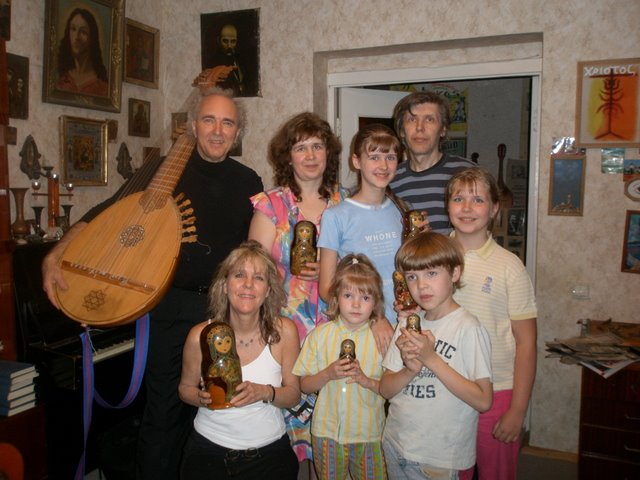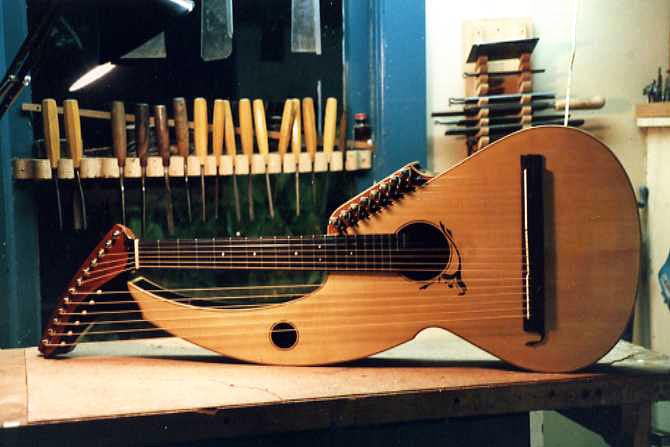On tour throughout Europe and Russia, John and Deirdra Doan spent some time with Jay Buckey and the family of Vadim Viksnin in Kiev. John got a chance to play with a beautiful hand-made torban.
Category Archives: Beyond Six Strings
Beyond Six Strings – From Sor to Hendrix
Last October I had a chance to conduct a Sor Symposium and debut a new show “Beyond Six Strings – from Sor to Hendrix” at Marylhurst University in Portland, Oregon. Months before I had an opportunity to talk with Peter Zisa who conducts the guitar program there about my research in the life and music of Sor, and he suggested that Marylhurst University host a Sor Symposium. Peter is not only a great player and elegant human being, he has such a great imagination and he coordinated with several teacher/performers in the area to have students come to a master class and themselves participate in the Symposium. Both the class and the Symposium went incredibly well.
Peter reviewed the event as follows:
“Marylhurst hosted an historic performance by John Doan on three beautiful and historic instruments. John’s blend of remarkable skills as a storyteller and masterful performer proved to be the highlight of the two-day Sor Symposium. John, who began his performance with his own music and arrangements on harp guitar, concluded the program with a historic premier performance of Sor’s music for the three-necked harpolyre. The pieces, which varied in level of technical difficulty from intermediate to virtuosic, charmed and moved the spellbound audience.”
Fan, Shannon J. Murphy, had this to say about the concert:
I was present at the concert at Marylhurst and was able to relive it as I read your account here. It was a beautiful presentation and I know your future audiences at this concert are going to love it as much as I did. Your description of Sor and his musical technique struck me as being just what I could say of you and yours. You are the instrument that makes the music flow. Continue to walk in the light.
In short, it was a kick!! It seemed crazy to combine in the same show the music of Fernando Sor – the “Father of the classical guitar” with the music of Jimi Hendrix and other contemporary guitar innovators but as the show evolved it flowed beautifully into an event that reached across time, generations, and cultures. Continue reading
The “Expanded” Harp Guitar – Adding Possiblities with Super-Trebles
In Volume 7, Issue 1 of harpguitars.net, John Doan wrote the article, ‘The “Expanded” Harp Guitar – Adding Possibilities with Super-Trebles.’
The playing and making of harp guitars today is causing a re-examination of many basic design features that go into making a fine guitar-like instrument with an expanded range. The six-string guitar world is alive and vital today but with the addition of sub-basses and super-trebles entirely new dimensions and fundamental questions arise that are not being commonly discussed among six-string guitar builders. I have concluded that after reviewing and playing many prototype designs today that simply having skills as a six-string guitar builder is not going to result in a great harp guitar. Harp guitar construction in many ways is a very different activity than building a six-string instrument.
The article examines the construction, enhancement, and benefits the super-trebles add to the harp guitar as he discusses the theory and techniques used to create the Sullivan/Elliott harp guitar John developed.
The Inevitable Harp Guitar: Recurring Cycles in Guitar Evolution
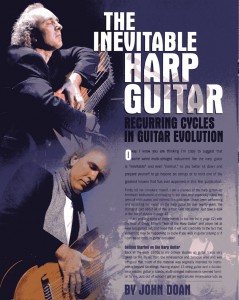 “The Inevitable Harp Guitar- Recurring Cycles in Guitar Evolution” was published in Fingerstyle Guitar Magazine No.66, and is used here with permission. For more information on harp guitar history go to harpguitars.net.
“The Inevitable Harp Guitar- Recurring Cycles in Guitar Evolution” was published in Fingerstyle Guitar Magazine No.66, and is used here with permission. For more information on harp guitar history go to harpguitars.net.
Back in the early 1970’s in my college studies on guitar I was very taken by the music from the renaissance and baroque eras and was intrigued that much of the material was originally intended for instruments beyond six strings. Having played twelve-string guitar and a double neck electric guitar in bands multi-stringed instruments seemed familiar to me. Just out of school I got an eight-course renaissance lute as well as a fourteen-course theorbo to play original lute music and included them in my guitar concerts.
Over time I began to recognize all sorts of multi-stringed instruments in some music shops, museums, and in books on instruments and was curious that hardly anyone played them or even seemed to know much about them. There were various lute-guitars (a.k.a. “lutars”) from late 19th/early 20th century Germany (those who think poorly of them call them “gututes”), Basse-guitares or Schrammel guitars from Europe (especially from Sweden, France, Germany, Italy and Eastern Europe), and harp guitars from early 20th century America.
These guitars all had an extended bass range with up to twelve additional strings. I even found a harp guitar made by Chris Knutsen in Port Townsend, Washington from the late 1890’s with seven additional super-trebles attached to the right of the ordinary six strings of the guitar. In time I acquired a Gibson harp guitar (literally hundreds were made in Gibson’s first twenty years), a Dyer harp guitar (made by the Larson brothers and still popular today especially since adopted by such great players like Michael Hedges and Stephen Bennett, among others), and various lesser known makes. I finally commissioned a twenty-string harp guitar (perhaps the first modern constructed harp guitar design in our times) from John Sullivan and Jeffrey Elliott of Portland, Oregon in 1985 and haven’t looked back since. *(note: William Eaton was building amazing multi-stringed creations of his own even before this). Continue reading
Beyond 6 Strings: Harp Guitar Renaissance
by John Doan, published originally in the September 1988 issue of Frets magazine
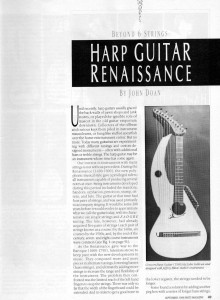 Until recently, harp guitars usually graced the back walls of pawn shops and junk stores, or played the ignoble role of mascot in the old guitar emporium downtown. Collectors of the offbeat and curious kept them piled in instrument mausoleums, or hung like stuffed spearfish over the home entertainment center, but no more. Today many guitarists are experimenting with different tunings and custom-designed instruments–often with additional bass or treble strings. The harp guitar may be an instrument whose time has come again.
Until recently, harp guitars usually graced the back walls of pawn shops and junk stores, or played the ignoble role of mascot in the old guitar emporium downtown. Collectors of the offbeat and curious kept them piled in instrument mausoleums, or hung like stuffed spearfish over the home entertainment center, but no more. Today many guitarists are experimenting with different tunings and custom-designed instruments–often with additional bass or treble strings. The harp guitar may be an instrument whose time has come again.
Predecessors to the Harp Guitar
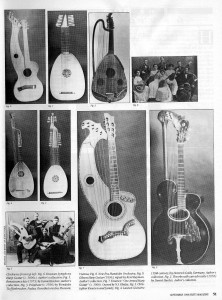 Our interest in instruments with many strings is not without precedent. During the Renaissance (1400-1600), the new polyphonic musical style gave a privileged role to all instruments capable of producing several notes at once. String instruments developed during this period included the mandora, bandora, orpharion, penorcon, stump, cittern, and lute. The guitar at that time had four pairs of strings, and was used primarily to accompany singing. It would be some 200 years before it would evolve to approximate what we call the guitar today, with its characteristic six single strings and EADGBE tuning. The lute, however, had already acquired five pairs of strings (each pair of strings known as a course) by the 1400s, six courses by the 1500s, and, by the end of the century, seven- and eight-course instruments were common.
Our interest in instruments with many strings is not without precedent. During the Renaissance (1400-1600), the new polyphonic musical style gave a privileged role to all instruments capable of producing several notes at once. String instruments developed during this period included the mandora, bandora, orpharion, penorcon, stump, cittern, and lute. The guitar at that time had four pairs of strings, and was used primarily to accompany singing. It would be some 200 years before it would evolve to approximate what we call the guitar today, with its characteristic six single strings and EADGBE tuning. The lute, however, had already acquired five pairs of strings (each pair of strings known as a course) by the 1400s, six courses by the 1500s, and, by the end of the century, seven- and eight-course instruments were common.
As the Renaissance gave way to the Baroque (1600-1750), lutenists strove to keep pace with the new developments in music. They composed more and more pieces in alternate tunings, lowering basses (bass strings), and ultimately adding more strings to increase the range and flexibility of the instrument. The problem they confronted was the limited reach of the left-hand fingers to stop the strings. There was only so far that the width of the fingerboard could be extended. And in order to get a good tone in the lower register, the strings needed to be longer. Continue reading

